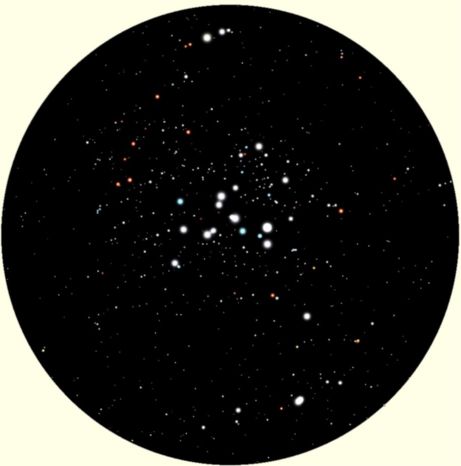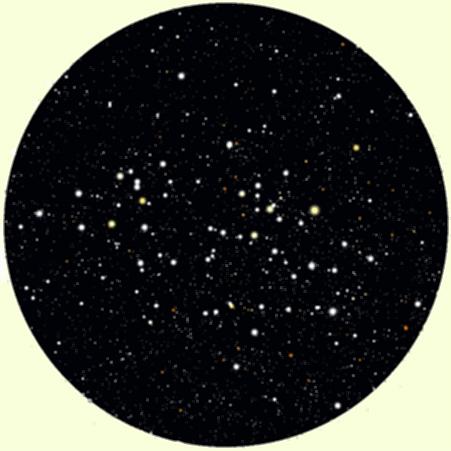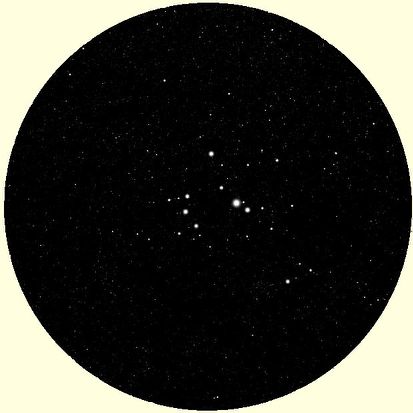OPEN STAR CLUSTERS : 3 of 10History of Open Star ClustersVisual DiscoveriesOf all the Open Clusters, the two most famous are the northern sky asterisms known as The Hyades and The Pleiades, have existed since ancient times. They are both these clusters are mentioned in Homer’s ‘The Iliad’ and also appear in the Bible. Perhaps the most famous biblical quote appears in Job 9, 9; “[He] who made the Bear and Orion, the Pleiades and the chambers of the south.” (10)According to Richard Allen’s Star-Names and their Lore and Meanings, the first written record of individual stars in these clusters were from Chinese annals in 2,357 BC, being star, Alcyone, then only 3° from the then vernal equinox. (11) The next identified record was around 325 BC, Aristotle (384 BC-322 BC) in his four-volume De Caelo (Of the Heavens.) reported the open cluster M41/ NGC 2287 as “a cloudy spot”. C.E. Barns was the has claimed this as “…possibly the faintest object recorded in classical antiquity.” M41 is likely the very first recording of a deep-sky object. Claudius Ptolemy (c.90 AD-168 AD) in c.138 AD found the next bright open cluster being M7 (NGC 6475) in the tail of Scorpius, who also noted in his ‘Almagest’ “…a lucid spot”. Another group is the Coma Berenices Star Cluster (12) (Mel 111) surrounding the star 15 Coma Berenices. Another three clusters ‘nebulosities’ are listed by Ptolemy — though it seems possibly that they were really discovered by the acknowledged ‘Father of Astronomy’ Hipparchus. (fl.160 BC to 125 BC) Brightest of the unresolved naked-eye clusters is known as the Praesepe or The Beehive, later catalogued it as M44 / NGC 2632 by Messier, which Ptolemy described as; “Centre of the cloud-shaped convolutions in the breast [of Cancer] called Praesepe.” The second (and third) was the famous far northern ‘Double Cluster’ (NGC 869 and NGC 854) in Perseus. Here Ptolemy describes; “At the tip of the right hand [in Perseus] and it is misty.’” Until the end of the 16th Century all these early found star clusters were classed just as unresolved nebulae. Each appeared as naked-eye clouds of opalescence, haze or lucid spots scattered occasionally along the Milky Way or among the constellations that follow this pathway. New Discoveries in the 17th CenturySince the advent of telescopes, as first gazed through by Galileo Galilei (1564-1642), found that some, if not all, of the Milky Way and the unresolved nebulae consisted of many many faint stars that were invisible to the naked-eye. Although he may have never explicitly saw any open clusters, the implications was clear that most, if not all, of these nebulae were composed of stars. Such views were not disproved until the discovery of the deep-sky class of objects — the planetary nebulae — that William Herschel discovered were composed of some unknown ‘stellar fluid’ surrounding the central star. This notion was finally concluded in 1864, when Higgins discovered many of the nebulae were true clouds of hot and luminous incandescent gas. First to examine the nature of the star clusters was the more recent recovered records of Sicilian-born Giovanni Batista Horierna (1597-1660). He examined and discovered several new objects sometime before 1654, including the southern open clusters Canis Major’s M41 (NGC 2287), M47 (NGC 2422/2478) and NGC 2451 both in Puppis, and the Tau Canis Majoris Cluster (NGC 2362). He also examined other bright clusters such as Praesepe (M44), the Double Cluster of Perseus (NGC 869 & NGC 884), Scorpius’ M6 and M7, and NGC 6231. Hodierna inspected these nebulae in some detail, categorising them into three principal types (13). 
Image of NGC 6231
|
| OBSERVER | RANGE | YEAR | ABB. | NOTES |
|---|---|---|---|---|
| Basel | 1 to 20 | 1979 | Ba | |
| Berkeley | 1 to 104 | 1960 | Be | |
| BH | 1 to 261 | 1975 | VdB-Ha | |
| Bochum | 1 to 15 | 1977 | Bo | |
| Collinder | 1 to 471 | 1931 | Cr | |
| Czernik | 1 to 45 | 1966 | Cz | |
| Dolidze | 1 to 47 | 1966 | Do | |
| ESO fff-nNNN | 133 OSC | 1982 | ESO | All Sky |
| Haffner | 1 to 26 | 1957 | Haf | Southern |
| Harvard | 1 to 21 | 1979 | Ha | Older 'H' |
| Hogg | 1 to 23 | 1965 | Ho | Southern |
| King | 1 to 26 | 1949,66 | Ki | Northern |
| Loden | 1 to 2326 | 1972-81 | Lo | |
| Lyngå | 1 to 15 | 1964 | Lynga | Southern Cen-Nor |
| Melotte | 1 to 227 | 1915 | Mel | |
| Pismis | 1 to 27 | 1959 | Pis | Southern |
| Ruprecht | 1 to 176 | 1960 | Ru | |
| Stock | 1 to 24 | 1956 | Stock | |
| Trumpler | 1 to 37 | 1930 | Tr | Mostly Southern |
| Turner | 1 to 11 | 2002 | Turner | |
| van der Bergh | 1 to 152 | 1975 | vdBergh |
NOTES:
* vdB-Ha van den Bergh and Hagen.
** fff-nNNN ESO field number plate :
Where; n object type SC for cluster NNN is the no. object in
field
*** Loden published five papers but all are sequential in
catalogue.
By the 1970s, there were an estimated 25,000 galactic open clusters in the Milky Way. These numbers have slowly risen to about 40,000 (1994), and some recent sources now even claim around 80,000 (2004). As a general subgroup, there are recognised about 1,600 (2002) well-established open star clusters that have been adequately investigated within about 4.0 kiloparsecs from the Sun. All of these are likely available to observe in amateur apertures.
Modern Open Cluster Catalogues
One of the first general catalogues on open star clusters was originally published in 1930 by the American Harvard University astronomer, Dr. Harlow Shapley. This catalogue appeared in the specialised book simply known as “Star Clusters” (1930), being the first astrophysical book specifically on all clusters. This catalogue contains some 250 cluster examples with general fundamental properties. Although much of the information is now quite obsolete, the data in many sources still remained in use for many decades.
After Shapley, the main catalogue for clusters and associations was the Alter, et.al “Catalogue of Star Clusters and Associations” first published in 1958 with subsequent editions in 1966, 1970 and 1981. Its main catalogue has all known references on open clusters, globulars and the associations, placed in a huge card file system. This once came in one purple coloured box that weights just over 5kg! Updates in the 1981 edition have several additional supplemental books. In writing text on clusters, this is particularly useful as the references the original data give a good view on the development of any selected cluster. (Having my own personal copy certainly helps!) Some of the historical parts of the observational descriptions of clusters (found elsewhere in these pages) have been determined using this reference. Needless to say much of this work is now obsolete, as much of the information in now available on the net through the either the CDS; Centre de Données astronomiques de Strasbourg or the ADS; Astrophysical Data Service.
One of the most recent catalogue in use is the ‘5th Lund-Strasbourg Star Catalogue’ or Lund Catalogue, being the ‘5th Open Cluster Data Catalogue‘ (OCD) (1987) that was first published by the Lund Observatory in 1981 by Göstå Lyndå. This contains a list of some 1 151 open clusters with each being identified by the IAU Cluster Designation, followed by the usual or traditional designation by the discovery and the cluster.
In 1970, the IAU based many of these designations on the decree by IAU Commission 37. (18). Although considered useful, its usage seems to be on the decline — probably because it uses the older B1950 coordinate system.
Lyngå’s 5th OCD is useful because it also contains a listing of many of the important open cluster parameters. It includes such normal things as the age and size of the cluster, but includes far more astrophysical data, such as E(B−V) magnitude or colour excess, the [Fe/H] (Iron to Hydrogen Ratio) and the observed turn-off colour point. Other sections of this catalogue includes the sub-division of known variable star types within each cluster.
A more recent edition has not been produced, but a newer one was created by W.S. Dias et al. “New Catalog of Optically Visible Open Clusters and Candidates“, originally published in A&A., 389, 871 (2002). This contains more recent updates but is given with less extensive summaries. Some 1600 open star clusters are listed, being 25% larger than the older 5th OCD. (See Webpage “Open Clusters and Galactic Structure”. It also has an important and useful List of Removed Clusters.)
Additional information given in this catalogue includes the mass estimation of the cluster in solar masses, and whether or not the cluster has any available photometry for useful analysis.
One of the more parts of these catalogues are the availability on the Internet based WEBDA. This useful Swiss based site is the work of the Laboratory of Astronomy at the Ecole Polytechnique (EPFL) in Lausanne, which began in 2002. It is presently developed and maintained by Jean-Claude Mermillion. WEBDA allows fast access to all current data on all open clusters. Also the site also gives some general information regarding “Cluster Parameters” by A.L. Tadross, P. Werner, A. Osman and M. Marie (2002). This contains information on the top two-hundred (200) clusters.
Another very useful amateur open cluster catalogue appears within the Willman-Bell 498 page book “Star Clusters“ by Brent A. Archinal and Steven J. Hynes (2003)
References and Endnotes
10. Sir William Drummond in the 19th Century, according to Allen (pg.362) states that this refers to the shape of the tail of Scorpius on the southern horizon looks similar to a chamber. Here the Pleiades is opposite the constellation of Scorpius. Others think that the reference may be referring to the Hyades.
11. This position is likely important because after this date the changing places of the Pleiades over the ensuing centuries would have highlighted the effect of the Precession of the Equinoxes. In early antiquity, the vernal equinox would have been known as the First Point of Taurus. Astrologically, the Pleiades position would have had highly significant importance, and this is suspected in a number of different cultures.
12. This should not be confused with the Coma Berenices galaxy cluster!
13. This is discussed in more detail in Archinal, B., Hynes, S. “Star Clusters” Section 1.3 ‘Early Telescopic Discoveries of Open Clusters’, pg.3. Published by Willmann-Bell.
14. M6 is the furthest south declinatin object in the entire Messier list
(14a) Perhaps had these clusters been observed by northern observers before this the story of open clusters might have been very much different — especially if this had been made by a Galileo or William Herschel. Astronomical advancement by these clusters alone may have shortened the finding of the stellar natures of clusters so much sooner. I.e. By about 50 to 100 years. Investigation of these objects in the southern skies did not really begin until the installation of the Great Melbourne telescope in the 1850s.
15. I have included open cluster M24 (NGC 6603), but this actual Messier discovery of this is debatable. According to Sky Catalogue 2000.0, Messier only describes the simple brightening of the Milky Way. Some, like Kenneth Glyn Jones in ‘The Search for Nebulae;’ (1975) claims it is “cluster with nebulosity.”
16. M104 to M110 were added by observations decided by several observers to produce an extended list. It was added during the 20th century. Méechain did find these objects using telescopic equipment similar to Messier. Galaxy M104, for example, was added by Flammarion in 1921, Hogg in 1947, Gingerich in 1960 and Kenneth Glyn Jones in 1966.
17. Distribution of clusters occupying the first half of the catalogue are intermixed between M16 and M45 (sixteen in all) were found between June and October 1764 within the first published forty-five (45) objects. Later M46, M47 and M48 were discovered on February 1771, M50 and M52 in early 1774, and the remainder between February 1777 and April 1781.
18. Details can be found in “Celestial Designations” by Fenandoz, Larlet and Spite F. (1983) and “The First Dictionary of the Nomenclature of Celestial Objects”; A&A.Sup.Ser., 52, 4, 1.1 – 7.14 (1983)
Last Update : 19th April 2017
Southern Astronomical Delights © (2017)
















